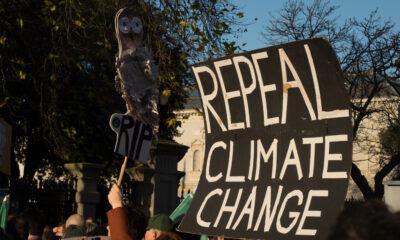Executive
The future of the electric vehicle mandate
The electric vehicle mandate could well be obsolete within a year, as new engines supersede the carbon-intensive Otto engines of today.

Just a few months after taking office, President Joe Biden issued an executive order setting a national goal for zero-emission vehicles to comprise at least 50% of all new cars and trucks sold by 2030. Then, in March 2024, the Biden Administration finalized new tailpipe rules for passenger cars and trucks.
From yesterday’s electric vehicle technology to new ways of thinking
Curiously, while the new rule is intended to “decisively” push the U.S. auto market toward electric vehicles and hybrids, the EPA backed off from its initial plan to ensure that two-thirds of all vehicles sold by 2030 were electric. The rule favors plug-in hybrids as part of the mix.
If anything, Vice President Kamala Harris (perhaps because of her California roots) is even more zealous than President Biden on the electric vehicle revolution, despite the fact that the $42 billion fast-charging initiative she is in charge of has to date produced nine stations.
Meanwhile, the European Commission a year earlier had agreed to “carve out an exemption” from its absolutist electric vehicle mandate only to allow the continued sale of vehicles that run on e-fuels (fuels made using captured carbon dioxide emissions).
While former President Donald Trump has vowed to end the Biden mandates and likely push to roll back the new EPA tailpipe rules (as he had done before), automakers on multiple continents are fast proving that government regulation all too often locks in yesterday’s technology.
Perhaps inspired by harsh realities that the 125-year-old electric vehicle technology (while much updated since its early days) even today has been unable to resolve nagging problems, automotive engineers on four continents are designing, and companies are manufacturing, vehicles that may soon turn the battery-electric vehicle into a 21st Century Edsel.
Deferring investments in electric vehicle manufacture
Many of these new engine designs will generate zero carbon dioxide emissions, but others will not. None of these vehicles meet the EU’s definition, and all of them appear to fall outside the Biden Administration’s plans, which are wholly keyed to battery-electric vehicles.
In an effort to salvage the Biden mandates, just last month, the Department of Energy announced $1.7 billion in new potential grants, mostly to General Motors and Stellantis, to convert existing plants in eight mostly swing states to manufacture electric vehicles and components. The program would not be finalized until after the November elections.
But just days later, General Motors CEO Mary Barra announced that GM is deferring investments in electric vehicles to ensure that “the company doesn’t get ahead of demand.” The firm is further delaying a second U.S. electric truck plant and the first Buick electric vehicle. It is now certain that GM will not reach its previously announced target of 1 million North America-produced electric vehicles by 2025.
Ford, which has racked up staggering losses on its electric vehicles (nearly $50,000 for each one sold), just announced it will spend $3 billion to expand production capacity at its Oakville, Canada, facility for its very profitable gasoline-powered, heavy-duty F-series pickup trucks. Ford had earlier postponed $12 billion in electric vehicle factory building, including a planned battery factory in Kentucky, citing consumer disaffection.
Flexible fueling
Meanwhile, Stellantis, the world’s largest automaker, just announced it is investing $6 billion into the South American market to build a generation of motors capable of running on either gasoline or Brazilian ethanol. The flex-fuel internal combustion engines will be able to switch between fuels at will. They can also be combined with plug-in hybrid technology, making a unique combination of the flexibility of the combustion engine, an electric motor, and a battery.
The new “bio-hybrid” family will include a basic bio-hybrid that integrates an internal combustion engine (a petrol detonation engine) with electrical drive; bio-hybrid eDCT which has a bio-hybrid power train with an electric dual clutch (EDC); and a bio-hybrid plug-in, an accessory plugged into the car for recharging.
Wisconsin-based Kohler Engines, a year ago unveiled its zero carbon emissions KDH hydrogen internal combustion engine that can use hydrogen sourced and developed by Kohler. The engine replaces the diesel injection system from a diesel engine with a G.I.D.E. system meant for hydrogen supply. Kohler’s move toward hydrogen is just one of many.
BMW has also decided to switch gears from electric vehicles to embrace hydrogen fuel cell technology. Triton EV has launched its own new hydrogen internal combustion engine, an innovation that originated in India. Toyota, Hyundai, and other companies are also building hydrogen-fueled internal combustion engines. Meanwhile, Volkswagen just announced plans to cut another 1,000 jobs at its electric vehicle factory in Zwickau, Germany.
Rotary engines and new thinking in hydrogen engines
On yet another front, Mazda recently announced the restoration of its “RE Development Group, with a focus on engineering and development of its trademark Wankel rotary engines. Mazda says the engine’s design allows linking the rotary engine with a lithium-ion battery pack. The company believes its lightweight engine that can operate on carbon-neutral fuels is a better solution than hydrogen fuel cell or pure electric vehicles.
And just days ago, EcoNews reported on a Toyota-designed hydrogen engine that eschews fuel lines and pumps and is very versatile when it comes to temperature – meaning it can operate in different climates and terrains equally, and with a high-grade cooling system. The Toyota fuel cell is capable of generating electricity without transitioning to heat.
The new Toyota news brings to mind a 2021 comment from Gill Pratt, the company’s chief scientist. “Different people have different circumstances and different needs.” That’s something the Biden and EU mandates had apparently forgotten in their subsidized crusade to force the entire world into a battery-electric future that economics and physics suggest cannot be achieved.
What this means is that, even if Kamala Harris is elected in November, the electric vehicle mandate may be dead in the water, killed by innovation.
This article was originally published by RealClearEnergy and made available via RealClearWire.
Duggan Flanakin is a senior policy analyst at the Committee For A Constructive Tomorrow who writes on a wide variety of public policy issues.
-

 Civilization4 days ago
Civilization4 days agoTrump’s Venezuela Gamble and America’s Shifting National Security Strategy
-

 Civilization4 days ago
Civilization4 days agoOperation Absolute Resolve: Anatomy of a Modern Decapitation Strike
-

 Civilization4 days ago
Civilization4 days agoTen Reasons To Cheer the Arrest of Maduro
-

 Civilization2 days ago
Civilization2 days agoOne Fell Swoop: Lawsuit Eyes Death Blow to Racial Preferences
-

 Civilization23 hours ago
Civilization23 hours agoTrump’s New Doctrine of Precision Deterrence
-

 Executive2 days ago
Executive2 days agoWaste of the Day: $1.6T in Wasteful Spending in Rand Paul’s “Festivus” Report
-

 Guest Columns3 days ago
Guest Columns3 days agoAdvice to Democrats Regarding Maduro Arrest: Resist Reflexive Opposition
-

 Civilization4 days ago
Civilization4 days agoTrump’s New Executive Order on Space Has the Right Stuff












